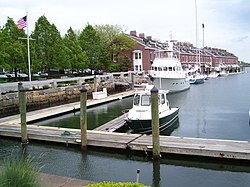Union Wharf | |
 | |
| Location | Boston, Massachusetts |
|---|---|
| Coordinates | 42°21′56″N71°3′3″W / 42.36556°N 71.05083°W |
| Built | 1795 |
| NRHP reference No. | 80000669 [1] |
| Added to NRHP | June 22, 1980 |
Union Wharf is an historic wharf at 295-353 Commercial Street in the North End of Boston, Massachusetts. The wharf began as a modest wooden structure in the late 18th century, and was developed with a complex of granite buildings roughly between 1830 and 1850. It was one of the major centers of trade on the Port of Boston in the mid-19th century, and served as a passenger terminal later in the 19th century. [2]
The wharf and buildings were listed on the National Register of Historic Places in 1980. [1]



